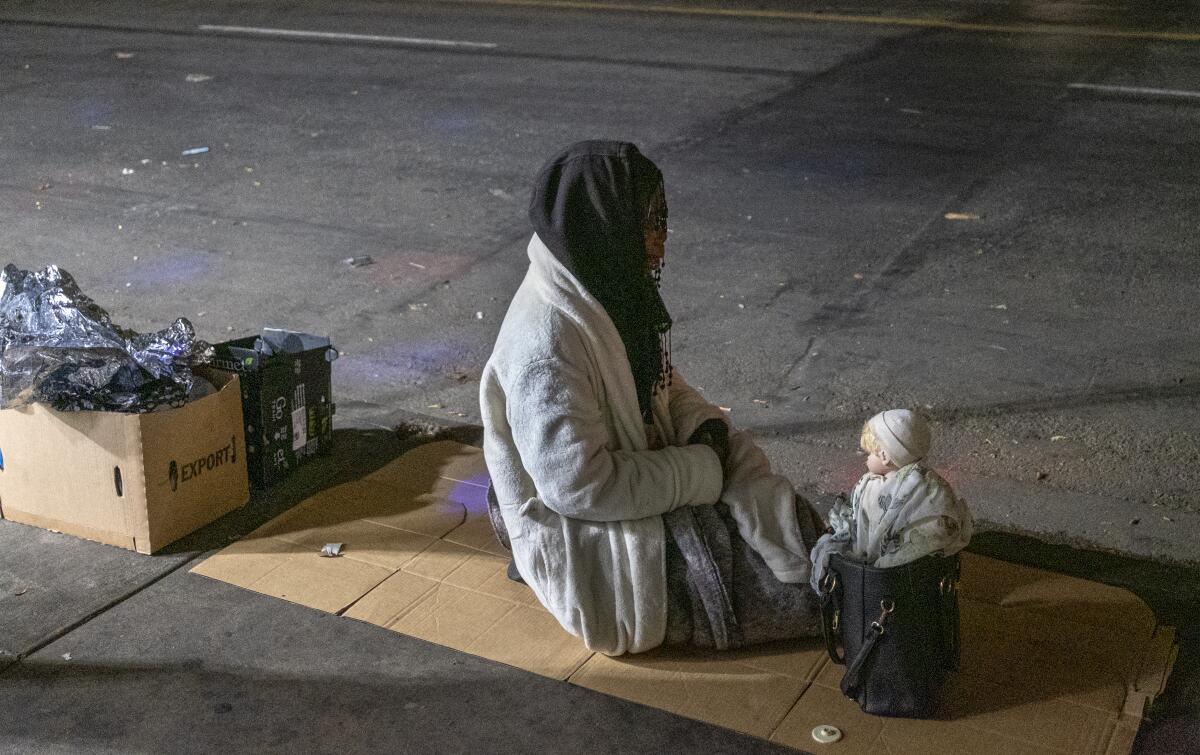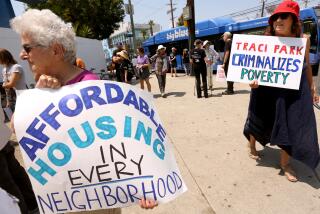Editorial: L.A.’s settlement of lawsuit over homelessness won’t do much about homelessness

More than two years ago, a group calling itself the L.A. Alliance for Human Rights and consisting largely of downtown Los Angeles business owners and residents filed a lawsuit against the city and county over their handling of homelessness. The group argued that officials had perpetuated and failed to address unsafe and inhumane conditions in homeless encampments on public sidewalks — endangering unhoused people and causing a public nuisance for everyone else.
This month, the city and the L.A. Alliance forged a proposed settlement that settles little about homelessness. Anyone expecting a road map out of homelessness with this settlement will find instead mystifying directives about whom to house and a plan that reinforces a balkanized, council-district-by-council-district approach to housing homeless people. The settlement also lays out a list of the county’s responsibilities, which is odd since the county isn’t party to the settlement. The county walked away from settlement talks weeks ago and said it would fight the suit in court.
The tentative terms of the settlement are not good. They leave too many homeless people out of the equation, don’t specify what proportion of housing should be interim vs. permanent and set the city on a path to enforce the anti-camping ordinance citywide before there is enough housing and shelter. These terms could, and we believe should, be modified before the City Council approves the settlement, which it is expected to do.
The settlement calls for the city to shelter or permanently house 60% of the city’s unsheltered population, which is 28,852. Unsheltered people make up the majority of the 41,000 homeless people counted in 2020.
But the terms of the settlement say the city can exclude from the 60% tally any people who have a serious mental illness, substance use disorder, a chronic physical illness or disability. The settlement classifies them as people “whom the city cannot reasonably assist.” Instead they are to be referred to the county for housing and treatment.
That’s ridiculous. Those are the most vulnerable homeless people who need to be off the streets as soon as possible. And they are the very people that permanent supportive housing — with wrap-around services and case management provided by the county — is designed for.
Yes, there are people with such severe mental illness that they need to be cared for in residential facilities (of which there are not nearly enough.) But they are a small number of the total homeless population reporting a mental health problem. Homeless people with mental illness or substance abuse issues are already living in permanent supportive housing all over the city and the county.
The settlement is also problematic because it won’t result in any new building. The city estimates it will need to provide between 14,000 and 16,000 shelter beds or housing placements to meet the terms of the settlement. Most of that need will be filled with the thousands of units of permanent housing already in the works — funded mostly by the $1.2-billion bond measure, Proposition HHH — and rooms in the hotels and motels that the city is in the process of buying.
We didn’t need a settlement for that. It is good though to see that a large chunk of the city’s commitment is permanent housing — which is the only kind of “placement” that transforms people from homeless to housed.
The settlement also commits the 15 City Council districts to coming up with placements for 60% of unsheltered people in each district. Of course, every council district should come up with a significant amount of housing and shelter for the unhoused in their district. But we’re concerned the settlement’s mandate will result in council members becoming so territorial that they object to an available bed or housing unit in one district being used to help a homeless person from another district. The settlement should be executed citywide.
What many council members like about the 60% threshold is that, under the settlement, once a district meets that requirement, anti-camping ordinances can be enforced in the district. Downtown property owners who are members of the L.A. Alliance benefit as well. Last year, in court filings for a preliminary injunction to force the city to shelter people on skid row, among various reasons cited, the group noted that the encampments were “preventing LA Alliance members from reasonably enjoying the use of their property.”
Under the settlement, no enforcement action could be taken until a homeless person is offered shelter or housing or a chance “to relocate,” as the settlement terms call it. But if the city is creating only a fraction of the necessary shelter or housing, then a lot of people will be left on the sidewalks. Theoretically, they should be left alone if there is no shelter to offer.
But advocates for homeless people suspect many of the offers will keep people stuck in shelters because there is no permanent housing to move up to or will be refused because it is in a part of town they don’t want to move to or in a place that limits the belongings you can bring in. That would allow law enforcement to shoo them from their campsites — causing them to simply camp elsewhere or be cited There’s no benefit to moving homeless people from one site to another around the city.
The proposed settlement would end the litigation against the city, but it won’t solve the homeless crisis. It may, however, allow city leaders to claim that they’ve dealt with the problem. If the court accepts the plan, the city council will need to go far beyond the inadequate agreement on the table.
More to Read
A cure for the common opinion
Get thought-provoking perspectives with our weekly newsletter.
You may occasionally receive promotional content from the Los Angeles Times.










